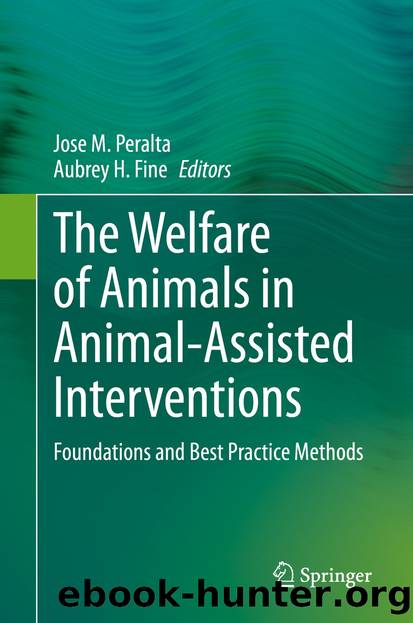The Welfare of Animals in Animal-Assisted Interventions by Unknown

Author:Unknown
Language: eng
Format: epub
ISBN: 9783030695873
Publisher: Springer International Publishing
5.4 Intervention Itself
The intervention is made up of the activities that occur between animal, handler, and participant in the context of that environment. These activities vary widely and may be potentially stress inducing to the animal. For example, physically demanding interventions such as a person putting pressure on a dogâs back to assist with balance is likely more stress inducing to the dog than a more passive intervention, such as a child reading a book to a dog. The intensity of the intervention is a major consideration for the frequency and duration of the animalâs ability to work because of the direct impact that it has on the animalâs long-term welfare.
Intensity should take into account the number of participants, the level of physical activity, and amount of direct contact it places on the animal. Physically demanding activities such as running, fetching, pulling objects, or supporting weight can be taxing on animals. High contact activities such as hair brushing were found to be more stressful to dogs than lower contact activities such as short walks (McCullough et al. 2018). While many animals may enjoy hair brushing, this activity can be irritating to an animal, especially when performed too aggressively. Therefore, the animalâs response to a high contact activity should be monitored to determine if it may be continued or should be halted. In addition, mentally demanding activities that require constant attention, such as performing or learning new tricks, may be considered intense. The more participants that are involved and solicit attention from the dog, the more intense the intervention as well. For example, therapy dogs were found to be more physiologically stressed when interacting with numerous children during playtime (de Carvalho et al. 2019). In contrast, it should be considered that low-intensity activities may be frustrating, and therefore stressful, for dogs that desire high levels of engagement and activity. Although there are no evidence-based guidelines to determine an acceptable level of intensity for an intervention because every individual animal has different limitations, it is the handlerâs responsibility to assess how the intervention is impacting the animal and to adjust practices accordingly.
While concrete attributes of the intervention can be modified to reduce intensity, such as decreasing the amount of contact or participants involved, one important consideration is to give the animal the freedom to express normal behavior (FAWC 2009). During AAIs, the animal is at the mercy of the handler and participantâs instruction and demands. Restricting control over an interaction increases the stress of the animal. In these situations, giving the animals choices and freedom will reduce the impact that a structured AAI may have on their physical and mental well-being (Hubrecht et al. 1992). An AAI may be guided by the natural and spontaneous behaviors of the animal without instruction and framing the intervention around the animalâs lead. Although a nonconventional way of conducting an AAI, this tactic of giving the animal personal choice and freedom enhances animal welfare because it also gives the animal the opportunity to take a break out of its own volition.
Download
This site does not store any files on its server. We only index and link to content provided by other sites. Please contact the content providers to delete copyright contents if any and email us, we'll remove relevant links or contents immediately.
What's Done in Darkness by Kayla Perrin(25501)
Shot Through the Heart: DI Grace Fisher 2 by Isabelle Grey(18220)
Shot Through the Heart by Mercy Celeste(18160)
The Fifty Shades Trilogy & Grey by E L James(17777)
The 3rd Cycle of the Betrayed Series Collection: Extremely Controversial Historical Thrillers (Betrayed Series Boxed set) by McCray Carolyn(13190)
The Subtle Art of Not Giving a F*ck by Mark Manson(12915)
Scorched Earth by Nick Kyme(11834)
Stepbrother Stories 2 - 21 Taboo Story Collection (Brother Sister Stepbrother Stepsister Taboo Pseudo Incest Family Virgin Creampie Pregnant Forced Pregnancy Breeding) by Roxi Harding(11040)
Drei Generationen auf dem Jakobsweg by Stein Pia(10217)
Suna by Ziefle Pia(10186)
Scythe by Neal Shusterman(9265)
International Relations from the Global South; Worlds of Difference; First Edition by Arlene B. Tickner & Karen Smith(8614)
Successful Proposal Strategies for Small Businesses: Using Knowledge Management ot Win Govenment, Private Sector, and International Contracts 3rd Edition by Robert Frey(8419)
This is Going to Hurt by Adam Kay(7698)
Dirty Filthy Fix: A Fixed Trilogy Novella by Laurelin Paige(6454)
He Loves Me...KNOT by RC Boldt(5805)
How to Make Love to a Negro Without Getting Tired by Dany LaFerrière(5378)
Interdimensional Brothel by F4U(5305)
Thankful For Her by Alexa Riley(5164)
